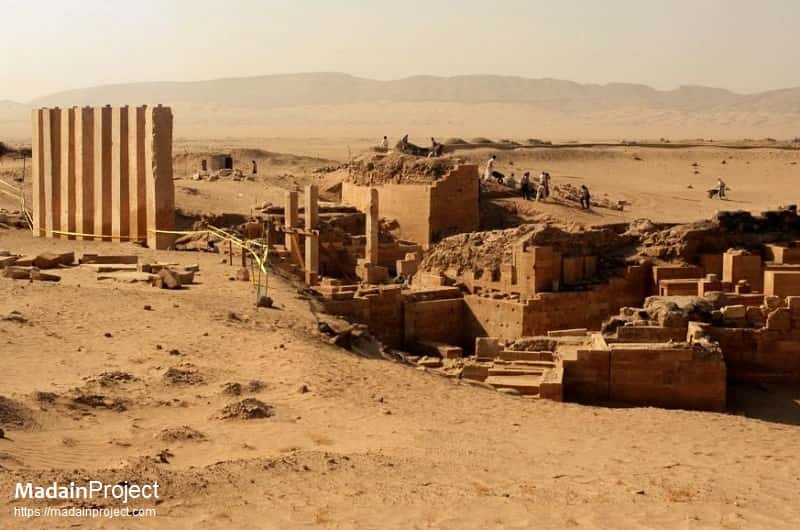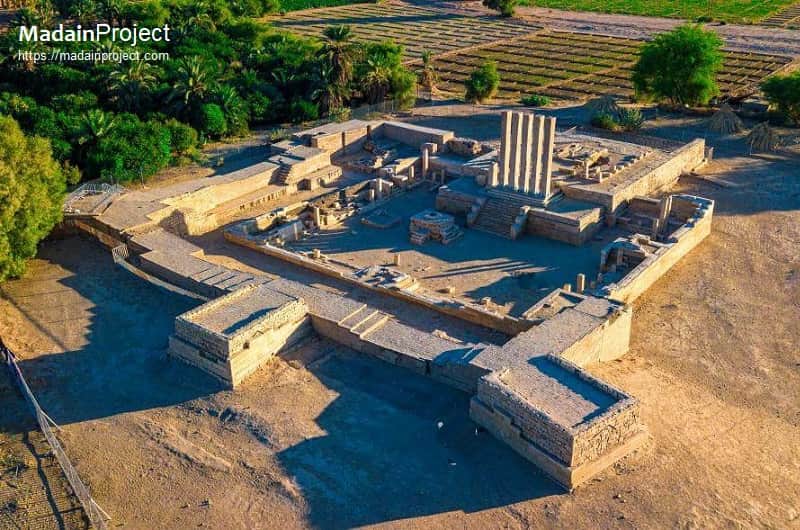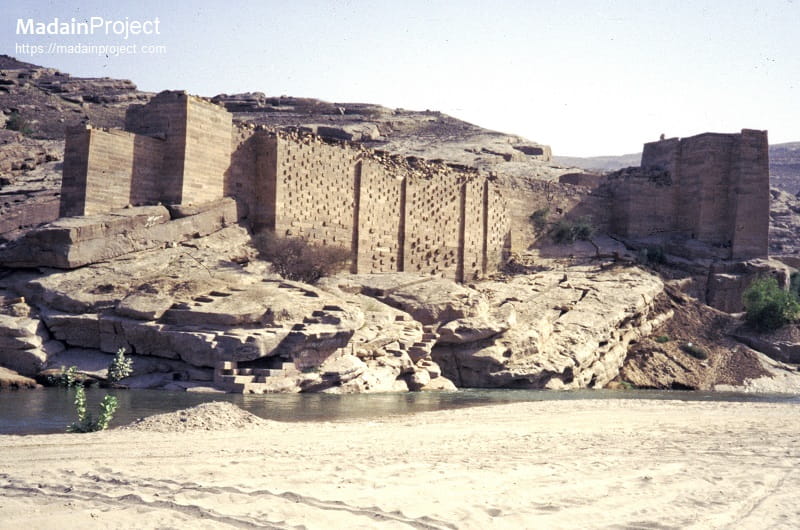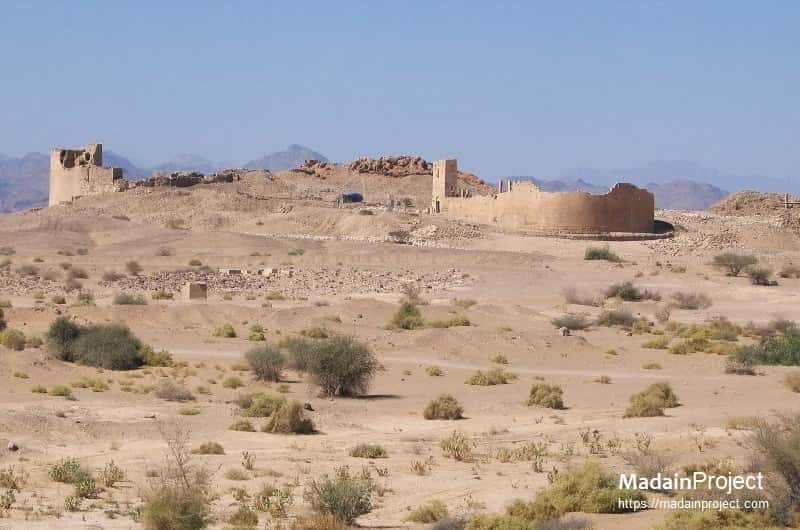The ancient Marib was the capital of the ancient kingdom of Saba (Arabic: سَبَأ), which some scholars believe to be the ancient Sheba of biblical narrative. The ancient Sabaean kingdom was based around the area of Marib, with some territory in northern Yemen. The Sabaean kings made their capital at Marib, and built great irrigation works such as the historic Marib Dam, whose ruins are still visible.
The Marib Dam supported a flourishing culture for more than a thousand years. They also built fortifications, temples and other cultic structures in the area, including, most notably the temples dedicated to Almaqah at Awwam and Barran. Saba was known for trading in the lucrative frankincense and myrrh and being one of the important trade posts on the ancient Incense Route. The Sabaeans were a seafaring people and were known to have influence and a population in the Northeast African kingdom of Dʿmt, across the Red Sea in Eritrea and Abyssinia, the only other source of both frankincense and myrrh.
The site of ancient Marib was largely abandoned during the twentieth century CE. Although a small village remains, the multi-story mud-brick buildings of the historic city are largely in ruins. The modern town of Marib is about 3.5 kilometres (2.2 miles) north of the center of the ancient city.
Early Settlement and Protohistoric Foundations
The earliest occupation (circa 2500–1200 BCE) of the Marib region in central Yemen can be traced to the late third millennium BCE, during the protohistoric period of South Arabia. Archaeological evidence from surrounding wadis and rock art traditions indicates the presence of semi-nomadic agro-pastoralist communities, who began exploiting the seasonal floodwaters of the Wadi Dhana. Though Marib had not yet emerged as a centralized polity, the gradual development of irrigation techniques, most notably early canal systems, laid the infrastructural foundations for later state formation. This period marks the beginning of complex socio-political organization and water management in the area that would eventually become the Sabaean heartland.
Early Sabaean Kingdom and Formation of Marib
Marib’s rise (circa 1200–800 BCE) as an urban center coincided with the formation of the Sabaean kingdom in the early first millennium BCE. By the twelfth century BCE, inscriptions suggest the establishment of a centralized monarchy and a religious-political complex centered around the moon-god Almaqah. Marib emerged as the royal and religious capital, anchored by monumental constructions such as the Great Dam of Marib (Sadd Marib) and the Mahram Bilqis (sanctuary of Almaqah). The integration of hydraulic engineering, temple economy, and tribal alliances facilitated the consolidation of Sabaean authority and its expansion into surrounding territories.
Classical Sabaean Period
During this period (circa 800–400 BCE), Marib functioned as the undisputed capital of a powerful and expansionist Sabaean kingdom. The city became a hub for incense trade routes connecting South Arabia with the Levant and Mesopotamia. Monumental inscriptions from this era, such as those of Mukarrib Karib’il Watar, document military campaigns and temple dedications, reflecting a theocratic kingship supported by priesthood and aristocracy. The Great Dam was expanded during this time, enabling year-round agriculture in the Sabaean core and contributing to Marib’s prosperity and symbolic stature. Urbanization intensified, and Marib evolved into a densely built city with administrative and ceremonial quarters.
Late Sabaean Period and Rival Polities
The later Sabaean period (circa 400 BCE–100 CE) saw internal fragmentation and the emergence of rival South Arabian kingdoms such as Qataban, Hadramawt, and Himyar. While Marib remained the ceremonial and titular capital of Saba, political power fluctuated and decentralization became evident. Dynastic rivalries and shifting alliances among the major tribal confederacies weakened the Sabaean monarchy. However, Marib retained its strategic and religious importance, continuing to house major sanctuaries and serving as a reference point in inter-regional inscriptions and dedications. By the first century CE, evidence indicates Sabaean attempts to reclaim dominance under rulers such as Ilsharah Yahdib and Wahb’el Yuhan’im, with Marib still functioning as their seat of power.
Himyarite Conquest and Decline
By the early centuries CE, the Himyarite kingdom, based further south in Zafar, gradually eclipsed Saba in military and political strength. Around the late third century CE, Himyar annexed Marib and absorbed Saba into a broader South Arabian hegemony. While Marib retained some administrative and ritual functions, it lost its primacy as a political capital. The Great Dam, though still in use, suffered intermittent damage due to reduced state oversight and maintenance. The final catastrophic breach, traditionally dated to the late sixth century CE, marked the symbolic and functional decline of the city. By the time of the Aksumite invasions and eventual Islamic conquest, Marib had become a marginal town, its former grandeur preserved only in ruins and memory.

The Awwam Temple, is an ancient archaeological site located in Marib (Maʾrib), Yemen. It was a significant religious structure in the Kingdom of Saba, a pre-Islamic civilization in the Arabian Peninsula. The temple is renowned for its historical and architectural importance, serving as a testament to the rich cultural heritage of the region. Excavations and research have shed light on the religious practices and societal dynamics of the ancient Sabaeans who worshipped at this temple complex. Read more

The Barran Temple is an ancient archaeological site located on the western side of the Safer – Marib road. It is renowned for its five magnificent columns, each over twelve meters high. The temple holds historical significance as a religious structure, reflecting the cultural heritage of the region. Excavations and research provide insights into the religious practices and societal dynamics of the ancient civilizations that once inhabited the area. Read more

The ancient city of Marib, located in modern-day Yemen, was the capital of the Kingdom of Saba, also known as Sheba. It flourished during the first millennium BCE and was renowned for its advanced civilization, architecture, and irrigation systems, including the famous Marib Dam. The city served as a significant center of trade and culture, and it played a crucial role in the incense trade route, which connected southern Arabia with the Mediterranean world. Marib is rich in historical and archaeological significance, with remnants of its ancient structures and infrastructure providing insights into its prosperous past. Read more

The ancient Marib Dam, constructed during the Sabaean period in ancient Yemen, was a significant feat of engineering. Its construction allowed for the development of extensive irrigation systems, fostering agricultural prosperity in the region. The dam's existence contributed to the growth and prosperity of the Sabaean Kingdom, as evidenced by the flourishing civilization around Ma'rib. However, the precise dating of the dam's construction and operation remains a subject of scholarly debate, with estimates placing its period of activity between the beginning of the Christian era and the end of the third century CE. Read more

Sirwah, an ancient city in Yemen, was surrounded by a defensive wall and contained large buildings, showcasing its historical importance. The city's ruins are significant archaeological sites, contributing to Yemen's rich cultural heritage and history. Read more
Signup for our monthly newsletter / online magazine.
No spam, we promise.